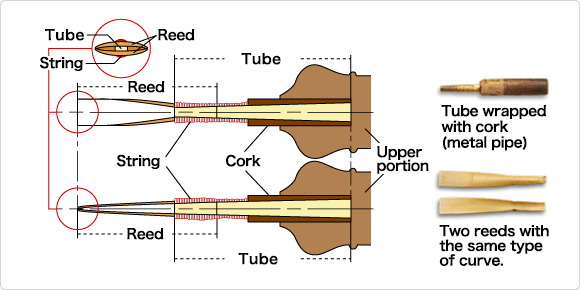The Structure of the Oboe
The double-reed mechanism
What exactly is a "double reed" ?
An oboe reed is made from two pieces of cut cane, which is why it's called "double" reed. They are strapped to a metal pipe face-to-face by a string. The cork portion attached around the metal pipe fits into the upper joint socket.
The two reed 'blades' are curved subtly, so as the side edges meet, a small aperture will be formed in between. This is where the breath passes through. When played, the reed vibrates minutely in a way that this aperture would close and open repeatedly (see next section for details).
The structure of the double reeds

What mechanism is behind a sounding oboe?
While holding the reed between the lips and gradually blowing air into the column, the air pressure decreases and pulls the two reed blades closer. Once the reed blades touch each other and the aperture closes, a sonic wave is generated as if you've clapped your hands. The sound pressure travels through the instrument bore, and reflects either at the tone-hole or at the end of the bell. The reflected wave subsequently returns to the reed, which has re-opened due to pressure recovery, allowing the air to pass through once again. All this happens over and over at enormous speeds. An oboe playing the "A" sound at 440Hz would repeat this cycle 440 times each second.
The structure of the double reeds
Musical Instrument Guide:Oboe Contents
Structure
How to Play
How the Instrument is Made
Choosing an Instrument
Trivia
- Why does the oboe lead the orchestra in tuning?
- Do the reeds have a front and a back?
- The keys recoil via springs!
- This is how the oboe and the cor anglais differ
- The charumera was the oboe's cousin
- You can reduce time spent breathing using circular-breathing techniques?
- The Wiener oboe that survived an existential crisis
- Oboe masterpieces: concertos
- Oboe masterpieces: chamber music
- What is the alto oboe?
- The heckelphone, which resembles the oboe
- The oboe is the bassoon's cousin
